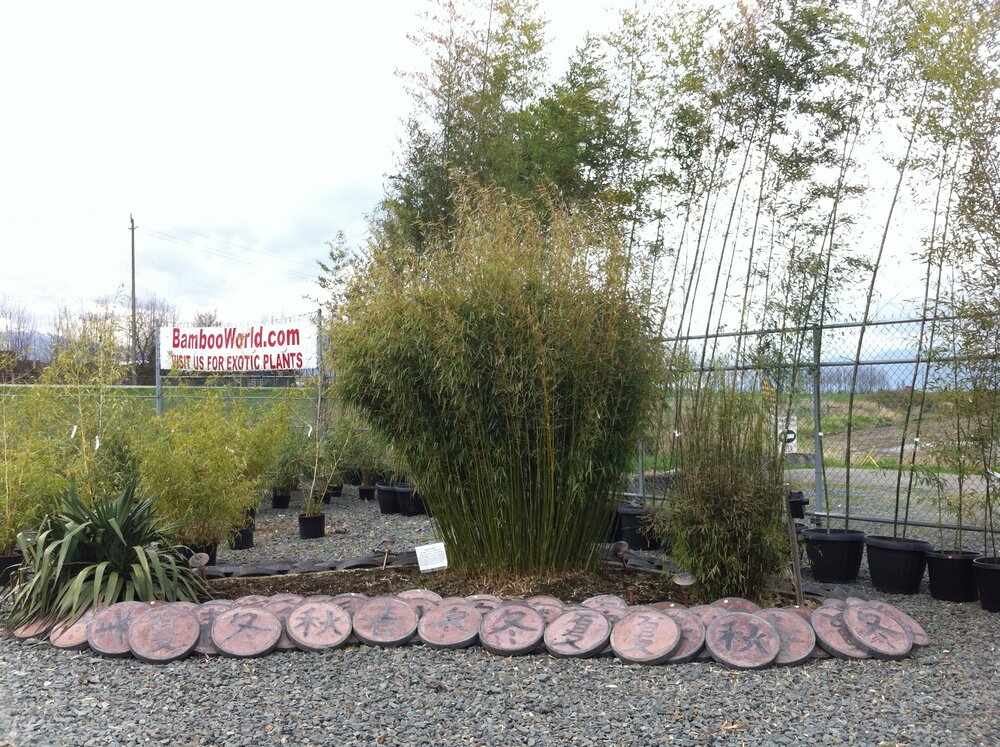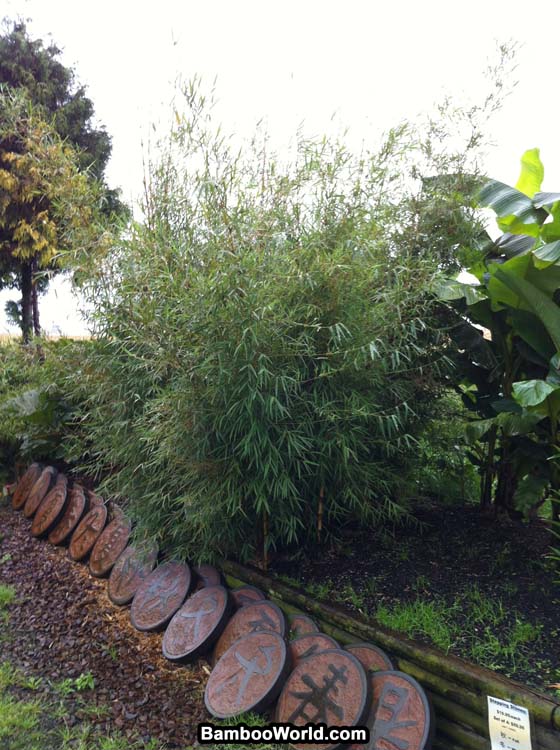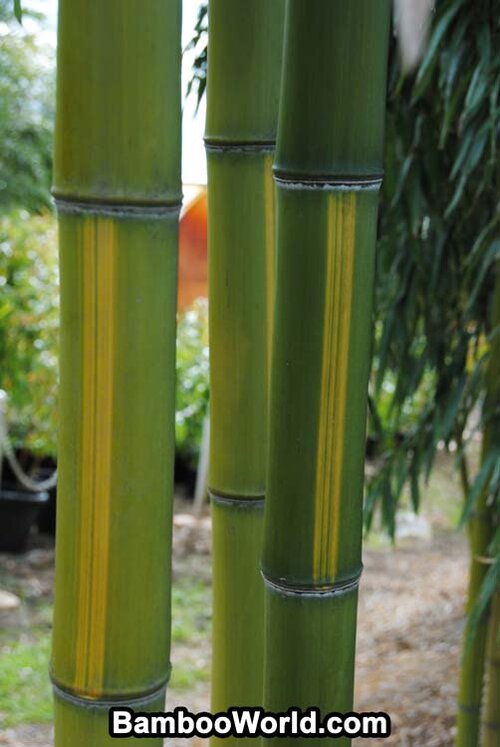
Choosing the variety of bamboo that suits your style and space can make all the difference in transforming your garden into a vibrant oasis. In this comprehensive guide we will explore key factors to consider when selecting the perfect species for your specific needs and preferences.
Are you planting in a pot or the ground? Sun or shade? Harsh conditions?Planning on harvesting your bamboo for an eco-friendly building material, or for food? If this all seems overwhelming to you, don’t worry. We’ve got you covered. From size and growth habits to climate requirements and aesthetic appeal, we’ll cover everything you need to know to make an informed decision.
Our articles have a focus on cold-hardy, temperate species of bamboo that thrive here in the Pacific Northwest. Some of these plants are hardy all the way to -32C, and have been grown successfully in many areas across Canada. To read more about our cold hardy favourites read our article “_[under construction]_”
The first most important question you should ask yourself is if you should get a runner or a clumper. Knowing the difference between these two subcategories of bamboo will help you a great deal when it comes to choosing which type of bamboo to get. Each have different growing characteristics that can be suitable for different preferences or goals.
Clumping bamboo is much easier than running bamboo by nature. There’s no fear of an uncontrollable spread with these varieties, and they almost never get pests, but they grow slowly compared to runners, only send up new shoots inside of and within a few inches of where the main plant is, and are much smaller. (Our tallest clumper that thrives in zone 5 maxes out at 18 feet.) No barrier or alternative plan is needed with these low-maintenance varieties.
Over-all they’re quite hassle free and do well either in the ground or containers. Just make sure to handle these guys with care when transplanting-they’re more susceptible to shock than most of the running types. Read more about avoiding transplant shock with this article [here].
The maximum height you can expect from clumpers is between 8-18ft depending on the variety. The canes are also quite a bit thinner and typically more tightly packed. These species are also more “bush-like” than runners in their appearance.


Running bamboo is probably what you picture when you think of bamboo. It has that traditional bamboo look, an array of vibrant colours to decide from, it’s usually tall by nature (the majority are 25ft and above at their maximum height unless kept in a container), and offer varieties with the thick stocks that are great for building, but some species still stay quite thin. Last but not least, these species grow and spread fast! The potential downsides to runners are that they can spread aggressively compared to their low-maintenance clumping counterparts. Once established, if planted in the ground the perimeter of these guys should be maintained yearly. To read about perimeter maintenance click [here.] Another option is installing a bamboo barrier, which we offer for sale [here.]
Some running bamboos take things to the next level with their monstrous size. These guys like to give space between their canes when given the chance, and also offer chunky canes that are sure to bring an enchanting essence to your garden: “_10 temperate timber bamboos that would probably make a forest if you let them_” yet there are also a few dwarf varieties below 10 feet that you can read about [here]
The majority of people who come to us have a goal in mind. Whether it’s blocking out their neighbors for privacy, replacing dead cedars, controlling soil erosion, for aesthetics, or for self sustainability, bamboo seems to have something for everybody.
There are a ton of species of all sizes- both runners and clumpers- that make an excellent, dense, privacy screen. We’ve decided to write about all the best bamboo species to use for this purpose. You can also read more about how to create a privacy hedge here [here]
If you plan on building with your bamboo, we have provided a list of options here [he10 strongest bamboo for buildingre]. Just be sure not to skip our article about proper preservation methods [here] to keep the integrity of your work lasting throughout the years.
If your goal is growing bamboo to harvest and eat, try out the varieties listed [here], but before you do, make sure to read about the proper harvesting techniques of bamboo [here] so that you know how to plan properly for a maximum yield. Also look at our article [here] about proper cooking techniques, keeping in mind that bamboo shoots are poisonous when not thoroughly cooked.
Unfortunately only a short list of bamboo thrives indoors. You can read about them [here]. Or if you’re brave enough you could try another variety with some indoor grow lights, you can read more about growing bamboo indoors [here]
Regardless of the sun exposure rating of our plants, the majority of them will grow in either sun or shade. That said, to get the most out of your bamboo it helps to put it in a spot where it gets the desired amount of sunlight. Generally the Phyllostachys species (runners) like a lot of sun, and will tolerate shade, meanwhile Fargesias prefer to get partial shade, but will adapt to sunny environments once it reaches a certain size. To choose a variety based off the sun exposure of the spot youre planting it check out [sun] and [shade].
If you happen to be planting in wet soil, you are limited to a short list of plants we have provided in our article [] keeping in mind that the other species require well drained soil, or they risk getting root rot.
Alternatively, we’ve written about drought tolerant bamboo [here] Watch out for brown leaf tips, that means over-watering!
We even have a list of bamboo varieties perfect for erosion control and retaining walls that we’ve listed [here]
Most people have a height in mind when it comes to our choice of bamboo, but our choices are limited to runners if you’re looking for anything above 18 feet. That said, you can always cut bamboo at its desired height, or keep it in a pot/container to stunt its growth if your goals are to have a shorter plant with the characteristics runners offer. There’s also a small selection of short runners we talk about in our post “_[coming soon]_” as well as tall clumpers we mention in our post “_coming soon_.
If you want something taller than what clumpers can offer, but you’re afraid of the risks runners can pose, let us explain how simple it really is to control runners in our article []. if that doesn’t convince you they’re not as scary as they seem, read [10 mistakes people make that actually make it worse when trying to control the spread of bamboo]. We also have a list of [slow growing runners that stay contained if given no reason to travel]. Container planting is another option that words nicely. Check our article [constrained area].
Don’t forget to check our article about these species of bamboo that thrive when given lots of space to spread, and have a spread out growth pattern. [something about bamboo forest]
If you have a vision for the perfect garden oasis, we’ve compiled some lists that should help narrow down your options based off your own personal preference. Are you drawn to the lush foliage of bamboo, or do you prefer the striking colours of its culms? Or maybe you have a particular use for your plant in mind?
For a tropical ambiance consider bamboo varieties with [large, vibrant leaves] that sway gracefully in the breeze. If you’re aiming for more of a contemporary or minimalist aesthetic, opt for a variety from [our list here of uprght bamboo].
For a dramatic focal point, you could choose bamboo varieties with contrasting culm colours. Combining the black stems of [nigra] with the golden hues of [spectabilis] is a brilliant example. Read more about bamboo pairings [here].
Additionally, consider how the bamboo’s growth pattern and size will fit into your landscape design, whether you prefer the [varieties that cascade], [varieties with variegates leaves], or whichever other style you may prefer.
Bamboo has a lot to offer in terms of colour variations. These striking plants cover everything from red to blue: [10 most colourful bamboos]
If you are looking specifically for a bamboo variety that is bushy from top to bottom, or one that is only bushy at the top, please take a minute to read our [guide on bamboo’s growth cycles and patterns] before reading our [list of top heavy bamboo].
